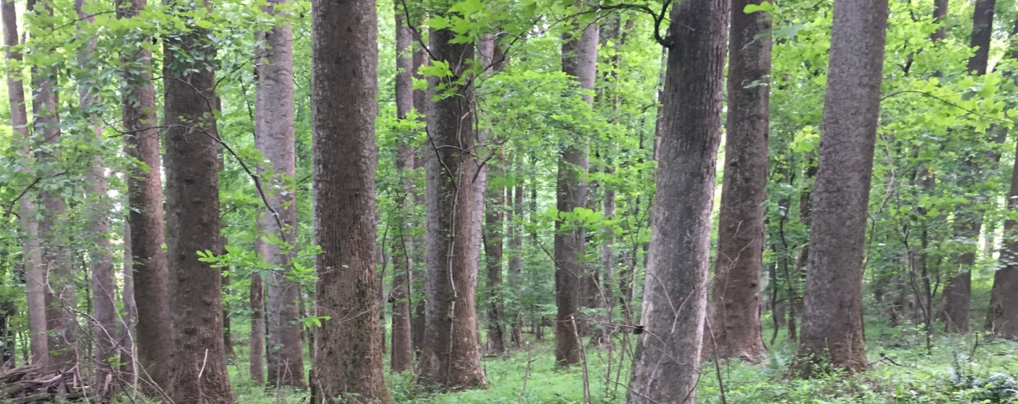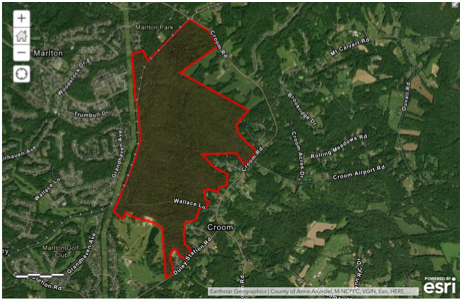Determining the Value of a Forest
Girl Scout Council of the Nation’s Capital Faces Decision about Marlton Forest
By Janet Gingold
July 31, 2022
 In 2019, the Girl Scout Council of the Nation’s Capital received a donation of 633 acres of forest. Now they must now decide how to use this resource wisely. Should they maximize its monetary value by selling to developers and use the proceeds to fund scout programming for decades to come? Or should they sell the land for conservation, preserving its value as a living ecosystem while putting somewhat less money in their coffers? Which decision is more in keeping with the scouting mission?
In 2019, the Girl Scout Council of the Nation’s Capital received a donation of 633 acres of forest. Now they must now decide how to use this resource wisely. Should they maximize its monetary value by selling to developers and use the proceeds to fund scout programming for decades to come? Or should they sell the land for conservation, preserving its value as a living ecosystem while putting somewhat less money in their coffers? Which decision is more in keeping with the scouting mission?
Scientists estimate that we need to preserve at least 30% of land in its natural state by 2030 to protect biodiversity, mitigate climate change, and reduce the ongoing threats to our biosphere by conversion of natural spaces to built-up areas. With the documentation of plummeting populations of insects and birds, as well as historic wildfires, heat waves and extreme precipitation events, we have clear warning that the balance of forces that support life as we know it has already been seriously disrupted. We need to save
Earth’s natural places not just for the sake of cute little creepy crawlies and wonderfully weird weeds, but for our own wellbeing. The air that we breathe and the food that we eat depend upon the natural systems that sustain us.
President Biden has embraced the 30x30 goal. However, in the US, most land is privately owned. Here in Maryland, 72% of forest acreage is privately owned. People can mostly decide what to do with the land that they own. Generally, land is valued for what someone might want to build on it or extract from it, not for the ecosystem services it provides. Without significant changes in how we value and manage our land, we will continue to see open space being paved over and built up faster than any ecosystem restoration efforts can replace what is lost.
So, what do we do? How can private landowners be part of the 30x30 solution? How do we limit the on-going loss of the privately-owned forests that actively remove greenhouse gases from the atmosphere, remove pollutants, absorb storm water, and and cool the air, land and water? How do we create a new land ethic that values forests for all the ecosystem services they provide, not just for what might be built if they are destroyed?
For over 100 years, the Girl Scouts have taught girls to be courageous and strong and responsible for what they do and say, to use resources wisely, and to make the world a better place. Today’s scouts are encouraged to participate in the Girl Scout Tree Promise to protect the planet from the effects of climate change. If even the Girl Scouts succumb to the lure of dollars for development, what hope do we have for the sustainable land use decisions we need to decrease the impacts of climate change?
While Prince George’s Plan 2035 calls for focusing development in already-developed areas, especially near Metro stations, and conserving green spaces, development projects outside the designated activity centers continue to convert natural resource areas to buildings and roads. The County’s new Climate Action Plan calls for no-net-tree-loss policies and preservation of natural places decrease impacts of climate change. To meet land-use and tree conservation goals, Prince George’s County will need to engage private landowners in conservation practices through regulations and incentives as well as land acquisitions. Much of Prince George’s County’s remaining forest and agricultural land lies between Route 301 and the County’s eastern border at the Patuxent River.
Currently, 52% of County land area has tree cover, but this varies greatly by subwatershed, with less tree cover in the inner, more urban suburbs and more tree cover farther from the city. According to the 2017 Land Preservation Parks and Recreation Plan, 17% of Prince George’s County’s 320,000 acres are publicly owned; of that, about 65% has tree cover. While the county currently owns about 30 acres of parkland per 1000 residents, planning goals call for 35 acres of parkland per 1,000 residents; this would mean increasing county-owned parkland from 28,671 acres in 2022 to 34,745 acres in 2040 to meet needs for projected population growth.
Prince George’s County has lost over 6,000 acres of forest in recent years. Satellite imagery shows clearly how housing developments and highways have encroached on nearby open space, making the conservation of remaining forested areas more important than ever.
GSCNC’s Marlton Forest – a 633-acre parcel of forest and wetlands -- lies southeast of Upper Marlboro between Route 301 and the Jug Bay Natural Area at Patuxent River Park. Satellite imagery shows the residential development of Marlton to the west and fields and forests to the east. At least since the 1930s, Marlton Forest has provided a wildlife corridor and home to diverse flora and fauna, including plants of conservation concern. Some readers might remember this undeveloped haven as the place where captive zebras ran wild in the summer of 2021. Its ecosystem services are valued at over $1.1 million annually according to the Maryland Department of Natural Resources.
Designated as part of a planned community (R-P-C zone) in 1969, this land has long been slated for development. It is separated from the existing community of Marlton by railroad tracks and a utility right of way. The 2021 county-wide zoning map amendment shows zoning categories ranging from residential estate with one dwelling unit per acre (pale yellow) to multifamily residential with 48 dwelling units per acre (brown), with a small area of open space (green). In February 2022, the County Planning Board approved a three-year extension on the Preliminary Plan of Subdivision dating back to the 1990s.
In 2019, when the Marlton developers donated the Marlton Forest to GSCNC, neighboring community members who advocated for conservation of the property thought that the forest would be spared. However, with Camp Aquasco nearby, GSCNC did not need another scout camp in Prince George’s County. GSCNC saw this donation as an opportunity to provide financial stability for their organization for decades to come. They had no intention of using the land for scout programs or placing it under a conservation easement. GSCNC has said that they need to recover $3 million lost during the COVID pandemic. They could receive over $10 million by selling the property for conservation. However, offers from developers might be twice that or more.
The Marlton Forest gift provides GSCNC with a unique opportunity to show how it lives lives by the Girl Scout Law. In a recent phone conversation, a GSCNC representative spoke of a responsibility to the organization to make the most of the donation. While very clear about GSCNC’s plans to get as much as they could from selling the land, she also indicated that the Board of Directors might take public opinion into account as they weighed various offers. Perhaps, if enough voices are raised – especially from girl scouts and volunteer leaders – GSCNC corporate leadership can be persuaded that that the highest value of Marlton Forest will be realized through conservation.
The Marlton Forest is currently on the market. Soon, the GSCNC Board of Directors will be faced with a decision about how to get the greatest value from this gift. By selling to Maryland-National Capital Parks and Planning Commission or another conservation organization, GSCNC could raise over $10M -- more than enough to compensate for $3M lost during the COVID pandemic – while also conserving the land for the ecosystem services it provides. Would this be enough or will GSCNC choose to sell to a developer who offers more money?
As the largest Girl Scout Council in the US, GSCNC has a real opportunity to lead by example as it makes this decision. Many other scouting organizations across the US are also looking at ways to sell off land to finance operations. Each land-use decision makes a difference. We need to conserve many small patches of green space to have a hope of reaching 30x30 goals and preserving the biosphere that sustains us.
You can help convince GSCNC that the value of the Marlton Forest is much more than the money developers could earn by replacing the forest with roads and buildings. Use this Action Alert to contact decision makers and urge them to conserve Marlton Forest. Help them see that in conserving the forest for its many ecosystem services – carbon sequestration, removal of pollutants from air and water, cooling by shade and evapotranspiration, absorption of storm water, providing wild life habitat and opportunities for people to connect with nature – they can truly help make the world a better place while also acquiring enough money to fund scout programs.
What is scouting for, if not to grow young people who will be responsible stewards of our natural resources as climate change unfolds around us?
Read more about this issue in the Washington Post.
